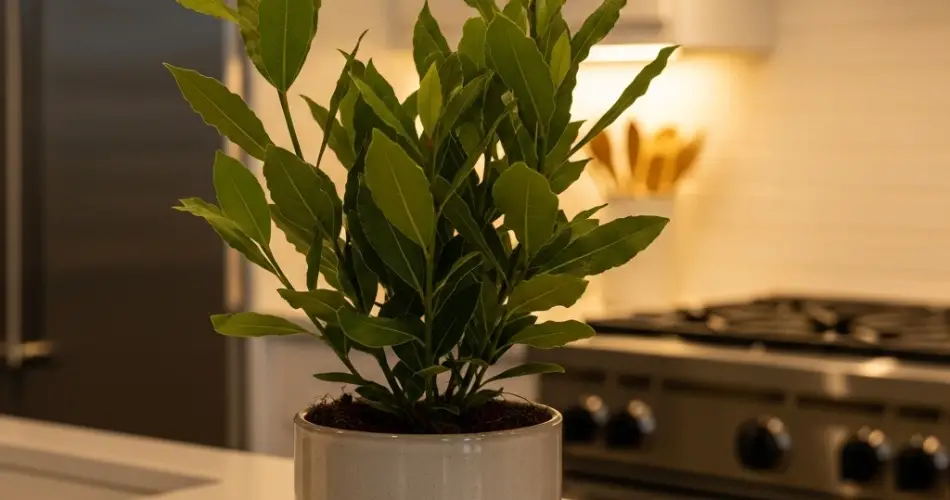Bay leaf trees (Laurus nobilis), also known as bay laurel, are evergreen herbs that add depth and aroma to soups, stews, and sauces. While commonly grown outdoors in warm climates, these aromatic trees can also thrive indoors in containers. With the right care and setup, you can cultivate a healthy bay tree right in your kitchen — providing a steady supply of fresh leaves for cooking all year long.
Here’s how to grow bay leaf trees indoors successfully, step by step.
Why Grow Bay Leaf Indoors?
Bay laurel is a slow-growing plant with glossy green leaves and a mild, woodsy fragrance. Keeping it indoors offers several benefits:
-
Convenient harvesting for daily cooking.
-
Protection from frost, especially in cooler climates.
-
Control over pests and diseases in a contained environment.
-
Decorative appeal, thanks to its upright growth and neat foliage.
Its compact growth habit and minimal mess make it well-suited for kitchen corners, sunny countertops, or even bright windowsills.
Choosing the Right Container
Bay trees need space to establish strong roots, especially if you want them to grow into a small shrub.
Choose a container that is:
-
At least 12–16 inches deep and wide
-
Made of ceramic, plastic, or terracotta
-
Equipped with good drainage holes to prevent root rot
Use a matching saucer to catch excess water and protect your flooring or countertops.
The Best Soil for Bay Laurel
Bay leaf trees prefer light, well-draining soil that retains moisture but doesn’t stay soggy.
Use a potting mix that contains:
-
Loamy base with added perlite or coarse sand
-
Compost or worm castings for nutrients
-
Slightly acidic to neutral pH (between 6.0 and 7.0)
Avoid heavy garden soil, which can become compacted and reduce aeration.
How to Start Your Indoor Bay Tree
While it’s possible to start from seeds or cuttings, most indoor growers begin with a young nursery plant, as bay trees are slow to germinate and mature.
To plant:
-
Add a layer of gravel or small stones at the bottom of the pot for extra drainage.
-
Fill the container halfway with potting mix.
-
Position the bay tree in the center and fill around it with more soil.
-
Water thoroughly, allowing excess water to drain out.
Press the soil gently to remove air pockets, but don’t compact it too tightly.
Light and Temperature Requirements
Bay trees thrive in bright, indirect sunlight. For best growth:
-
Place the plant in a south- or west-facing window with 6+ hours of light per day.
-
If natural light is limited, use a grow light for supplemental lighting.
-
Ideal indoor temperature is between 60°F to 75°F (15°C to 24°C).
-
Avoid placing the plant near cold drafts or heat sources like ovens or radiators.
During warm months, you can move the pot outdoors for better airflow and stronger sunlight, then bring it back in before the temperature drops.
Watering and Humidity
Bay trees don’t like to sit in wet soil, but they also don’t tolerate being completely dry for long.
-
Water when the top inch of soil feels dry to the touch.
-
Water thoroughly until excess drips from the drainage holes.
-
Reduce watering frequency during winter months.
Indoor air can be dry, especially in air-conditioned spaces, so lightly mist the leaves or place a humidity tray nearby to maintain proper moisture levels.
Feeding Your Bay Tree
Bay trees are light feeders, but occasional fertilization helps keep the foliage lush.
-
Use a balanced liquid fertilizer every 4–6 weeks during the growing season (spring to early fall).
-
Avoid overfeeding, which can lead to leggy growth and pale leaves.
In winter, reduce or stop fertilizing altogether to allow the plant to rest.
Pruning and Shaping
Regular pruning helps control the size and encourages bushier growth.
-
Pinch back the tips of young branches to promote branching.
-
Trim away any dead, yellowing, or leggy stems.
-
You can also shape the plant into a topiary or compact shrub for aesthetics.
Pruning also stimulates new leaf production, giving you more fresh leaves to use in the kitchen.
Harvesting Bay Leaves
Bay leaves can be harvested once the plant is well-established and growing vigorously.
-
Choose mature, dark green leaves, which have the strongest flavor.
-
Snip leaves as needed, avoiding large harvests all at once.
-
To dry, place harvested leaves between paper towels in a warm, dry spot for a few days.
Dried bay leaves can be stored in airtight containers for months without losing their aroma.
Common Problems and Solutions
-
Leaf spots or yellowing: Often caused by overwatering or poor drainage. Adjust watering habits and check soil health.
-
Leaf drop: Can result from sudden temperature changes or low humidity. Stabilize the environment and mist regularly.
-
Pests: Occasionally, scale or spider mites may appear. Wipe leaves with a damp cloth or use neem oil spray.
With regular monitoring, these issues can be quickly resolved.
Final Thoughts
Growing a bay leaf tree indoors is a satisfying way to keep fresh, aromatic leaves close at hand. With the right light, container, and care, you’ll enjoy not only its culinary uses but also its elegant greenery in your kitchen space. Whether you’re simmering stews or seasoning rice, nothing beats the flavor of homegrown bay leaves.



